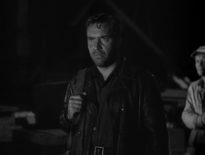Last week, Cinema Fearité celebrated Women in Horror Month by taking a look at Mary Harron’s American Psycho. We’re continuing the party this week by featuring another classic fright flick directed by a member of the fairer sex – Mary Lambert’s 1989 Stephen King adaptation of Pet Sematary.
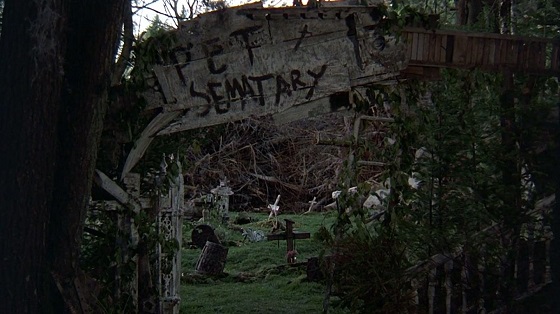
Pet Sematary is about a doctor named Louis Creed (Nightmare Weekend’s Dale Midkiff) who takes a new job and moves to rural Maine with his wife Rachel (Denise Crosby from “Star Trek: The Next Generation”), daughter Ellie (played alternately by Blaze Berdahl from “Ghostwriter” and her twin, Beau Berdahl from Strong Island Boys), and baby son Gage (New Nightmare’s Miko Hughes). While exploring their unfamiliar surroundings, the family notices a path behind their home, and neighbor Jud Crandall (Fred Gwynne, best known as Hermann Munster on “The Munsters”) leads them up the trail to the “Pet Sematary” (the misspelling is intentional), a place where local children bury their pets when they die.
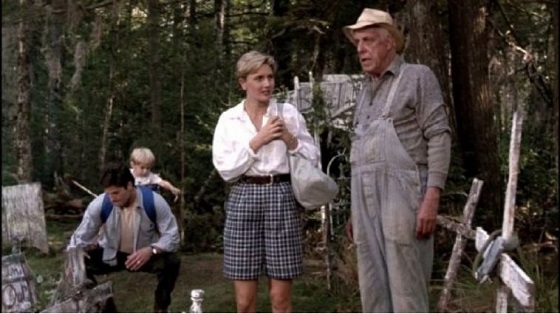
After Ellie’s beloved cat, Winston Churchill (Church for short), is run over by one of the many speeding trucks that frequent the road that runs by the family home, Jud takes Louis past the Pet Sematary, over a treacherous bramble, to an old Native American burial ground that supposedly has magical powers. Louis buries Church there, and the cat comes back to life. Only, instead of the loving feline he was before, Church is now mean and vengeful. When Gage is killed by a truck in the same way that Church was (that damn road!), Louis’ grief causes him to dig up the toddler’s body after the funeral and rebury it in the Indian graveyard. If it means seeing his son again, Louis is willing to risk the fact that Gage may come back just as demented as Church.
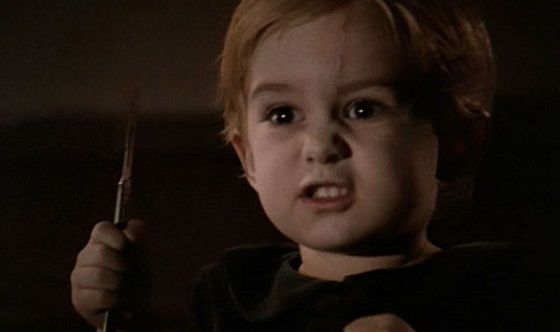
Famously critical of some of the early cinematic adaptations of his work (*cough* The Shining *cough*), Stephen King wrote the screenplay for Pet Sematary himself. Because of this, Pet Sematary is a fairly faithful adaptation of the book; there’s a little more Native American religious philosophy in the book, and Jud’s wife is in the picture, but those omissions just serve to streamline the plot for the screen. Having cut her cinematic teeth making music videos for artists like Madonna, Eurythmics, and The Go-Gos, Mary Lambert brought a stylistically hip-yet-maternally sensitive tone to the Pet Sematary table.
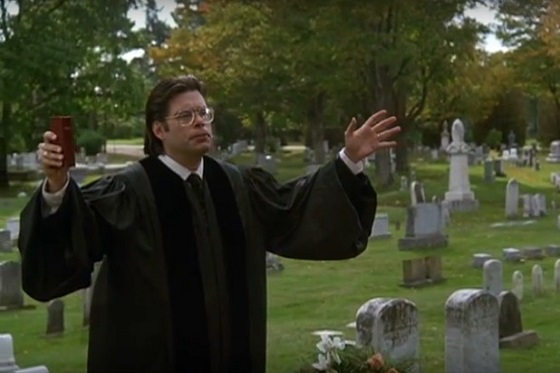
The combination of Lambert’s direction and King’s script produces some unforgettable moments in the film. Gage’s death is one of them, the camera lingering on the toddler’s empty shoes after the tiny baby was knocked right out of them by the massive semi. Gage’s funeral is another, with Louis getting into a fistfight with Rachel’s father and knocking over the casket, a heartbreaking little glimpse of the little boy’s hand just visible as the lid shakes open, then closes again. These are little things from King’s script that Lambert visualizes perfectly – and gut-wrenchingly.
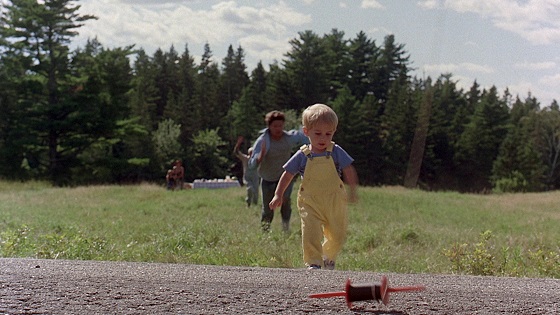
In a way, Pet Sematary is a brilliant mash-up of every conceivable horror subgenre while still managing to maintain the coherency of a single movie. It’s a zombie movie. It’s an animals-gone-wild movie. Louis and his family get subtle and subconscious advice from the spirit of a boy named Victor Pascow (Brad Greenquist from Lost Souls) who is killed on Louis’ first day on the job, giving the movie a ghost story element. Rachel is haunted by memories of a deceased sister named Zelda (Andrew Hubatsek from Human Resources) who suffered from spinal meningitis, so there’s a psychological thriller angle to it as well. Finally, in its last act, Pet Sematary turns into a good old-fashioned slasher flick. There’s something for everyone in Pet Sematary.
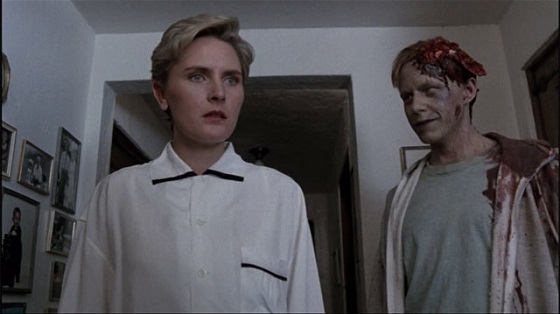
Pet Sematary was shot by cinematographer Peter Stein (Friday the 13th Part 2, C.H.U.D.) to look like a spooky pulp flick, with plenty of shadows and fog muting the neutral-to-bright color palette. It’s not exactly Creepshow, but the look of the film has a distinctly comic book tone to it. There’s not a huge body count, but the killings that do take place are good and gory, so the whole thing ends up feeling like a feature-length episode of “Tales from the Crypt.” As far as horror filmmaking goes, Pet Sematary looks great, the photography straddling the thin line between camp and substance.
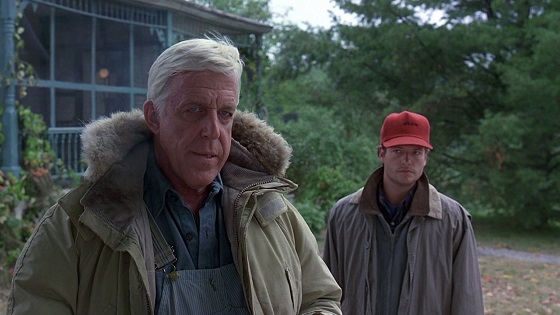
Composed by Elliot Goldenthal (Alien 3, Drugstore Cowboy), the musical score for Pet Sematary is notable because of what it isn’t; it’s not a typical eighties electronic score. It’s a throwback to the lush orchestral cinematic scores of the seventies, ranging from The Omen-esque faux-religious hymnals (the spooky choral theme from The Amityville Horror is even used in the trailer) to Psycho-like abrasive and cacophonous walls of dissonance and noise. Whether melodic or hostile, the score is always effective. Of course, because it’s a Stephen King story, rock and roll plays a part in it as well, and one of King’s favorite bands, The Ramones, contributed a pair of songs to the soundtrack, including the title theme which went on to become one of the group’s biggest mainstream hits (and, of course, consequently caused them to be labelled sellouts by their punk rock fan base).
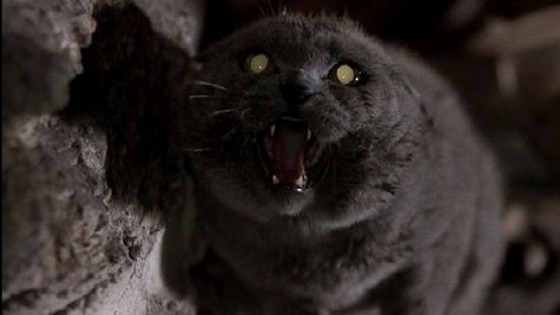
Mary Lambert would continue to dabble in music videos while working steadily in television and still finding time to make more horror movies like Urban Legend: Bloody Mary, The Attic, and, yes, Pet Sematary II. As for Stephen King, well, he continues to write to this day, and the nineties would see more of his horrifying stories turned into more horrifying movies like The Night Flier, It, and The Dark Half. And Pet Sematary, while it has been accused of stripping the nuances out of the book’s characters, still manages to be as close of an adaptation of a King novel as one can expect from a hundred-and-three-minute movie. And it’s pretty damn scary, too.
